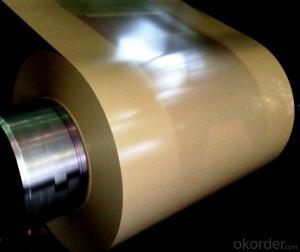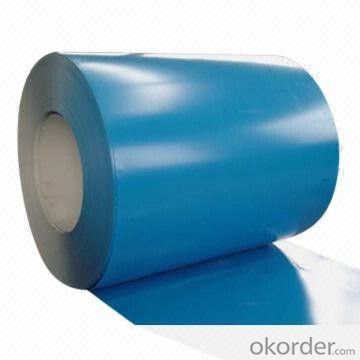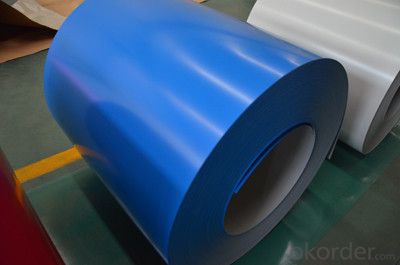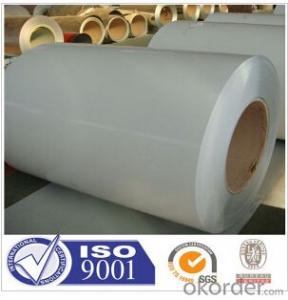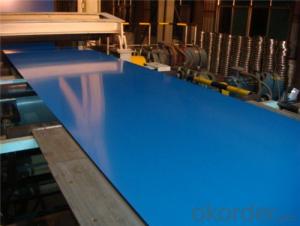BMP Z25 PPGI Rolled Steel Coil for Construction Roofing Constrution
- Loading Port:
- Shanghai
- Payment Terms:
- TT OR LC
- Min Order Qty:
- 100 m.t.
- Supply Capability:
- 30000 m.t./month
OKorder Service Pledge
OKorder Financial Service
You Might Also Like
Structure of BMP Z25 PPGI Rolled Steel Coil for Construction Roofing Constrution

Description of BMP Z25 PPGI Rolled Steel Coil for Construction Roofing Constrution
PPGI is made by cold rolled steel sheet and galvanized steel sheets as baseplate, through the surface pretreatment (degreasing, cleaning, chemical conversion processing), coated by the method of continuous coatings (roller coating method), and after roasting and cooling.
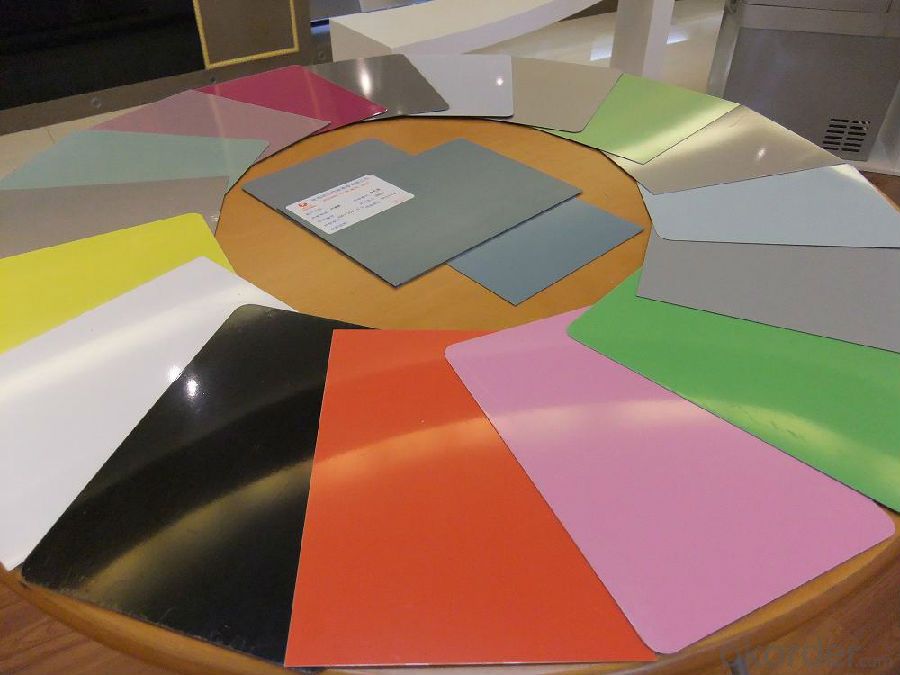
Main Feature of BMP Z25 PPGI Rolled Steel Coil for Construction Roofing Constrution
1. Aluzinc coating mass: 30g-275g/sqm
2. Coil weight:4-6 tons per coil
3. Edge treatment: Mill edge or cut edge.
4. Technical treatment: Bright annealed, flatting, cold harden.
5. Surface treatment: Annealed, bright finish, dull/bright finish, slit edge.
6. Spangle: Normal/small/big/zero spangle.
7. Delivery terms: FOB / C&R / CIF
Applications of BMP Z25 PPGI Rolled Steel Coil for Construction Roofing Constrution
If the yield point is not pronounced, the value applies to R p0.2 ; if the yield point is pronounced, the value applies to R el . When the thickness is less than or equal to 0.7 mm and greater than 0.5 mm, the minimum value for elongation is reduced by 2 units. For a thickness less than or equal to 0.5 mm, the minimum value is reduced by 4 units.it is ideal for a wide range of applications, such as pre-engineered buildings, architectural panels, roofing, siding, cladding, and many other building components.and also used back plate of appliance; wide range of construction, furniture industry, transportation industry, etc.

Specifications of BMP Z25 PPGI Rolled Steel Coil for Construction Roofing Constrution
Standard | ASTM A653, JIS G3302, GB/T3830-2006 |
Grade | SGCC, DX51D, A653, SGCH, Q235B |
Thickness | 0.125-1.0mm |
Width | 600-1250mm |
Base metal | Galvanized steel coils, Alumzinc steel coils, color coated steel coils |
Zinc coating | 40-275g/M2 |
Coil ID | 508mm/610mm |
Packing | Standard seaworthy export packing: 3 layers of packing, inside is kraft paper, water plastic film is in the middle and outside GI steel sheet to be covered by steel strips with lock, with inner coil sleeve. |
Delivery | Within 10-30days after signing contract |
Price | FOB& CNF& CIF price |
Payment terms | TT or LC, Western Union |
Capacity | 5000MT per month |
MOQ | 100MT |
Usage | construction, the manufacturing of cars, ships, containers and household electric appliances,other industries usage. |
FAQ of BMP BMP Z25 PPGI Rolled Steel Coil for Construction Roofing Constrution
We have organized several common questions for our clients,may help you sincerely:
1.Are you a factory or a trading company?
CNBM is a trading company in this industry over 30 years, located in Beijing
2.Are the products tested before shipping??
Yes, all of our PPGI and GI was qualified before shipping. We test every batch every day.
3.Why choose us?
ISO system
SGS and BV audited company.
Industry experience over 10 years.
Management systems-internal software
Finished product inventory-more than 500 tons.
Raw material inventory -over 800 mertic tons.
Shipment of goods -more than 30 countries worldwide.
We have the most convenient transport and prompt delivery.
We offer competitive price with best service.
We have high technical production line with top quality products.
We have win high reputation based on best quality products.
- Q: What is the lifespan of steel coils?
- The lifespan of steel coils can vary depending on various factors such as the quality of the steel, the conditions in which they are stored or used, and the maintenance practices employed. However, with proper care and maintenance, steel coils can last for several decades or even longer.
- Q: Is Carbon Steel strong for swords?
- Yes. Most high quality knives are made of carbon steel versus say stainless steel. High strength carbon steel holds an edge well and is strong.
- Q: What are the different methods of testing steel coils for quality control?
- Steel coils undergo various methods for quality control testing to ensure they meet the necessary specifications and standards. These methods encompass visual inspection, dimensional measurement, hardness testing, tensile strength testing, chemical analysis, coating thickness measurement, surface roughness measurement, ultrasonic testing, and magnetic particle inspection. Visual inspection is the most fundamental technique, involving a thorough examination of the coils for surface defects like scratches, dents, or irregularities. This method enables the identification of visible defects in the material. Dimensional measurement, on the other hand, utilizes tools such as calipers, micrometers, or laser measuring devices to evaluate the dimensions of the steel coils. The measurements are compared against specified tolerances to ensure they meet the required standards. To assess the resistance of the steel coils to indentation or penetration, hardness testing is performed. This examination helps evaluate the material's strength and durability. Common hardness testing methods include Rockwell, Brinell, and Vickers hardness tests. Tensile strength testing measures the maximum tensile stress a steel coil can endure before breaking or deforming. This test helps determine the material's strength, elasticity, and compliance with the required specifications. Chemical analysis is crucial in testing the composition of the steel coils to verify the presence of specific elements in the desired amounts. This ensures that the coils are made from the correct grade of steel and comply with the required chemical composition standards. In cases where the steel coils have a protective coating, it is vital to measure the thickness of the coating. Non-destructive testing methods like magnetic induction or eddy current testing are typically employed for this purpose. The coating thickness is compared against the specified requirements to ensure it provides adequate protection. Surface roughness testing evaluates the smoothness or roughness of the steel coil's surface using instruments like profilometers or roughness testers. This testing method guarantees that the coils meet the required surface finish standards. Ultrasonic testing utilizes high-frequency sound waves to detect internal defects like cracks, voids, or inclusions within the steel coils. This non-destructive testing method provides valuable information about the structural integrity of the coil. Magnetic particle inspection is employed to identify surface and near-surface defects in steel coils. By applying magnetic particles to the surface and detecting any magnetic leakage caused by defects using magnetic sensors, this technique effectively detects cracks and other surface abnormalities. By combining these testing methods, manufacturers ensure that the steel coils produced meet the necessary quality standards and are suitable for their intended applications.
- Q: What are the factors affecting the price of steel coils?
- There are several factors that can affect the price of steel coils. These include the cost of raw materials used in the production of steel, such as iron ore and coal. Additionally, the global supply and demand for steel can also impact prices. Other factors can include currency exchange rates, trade policies, transportation costs, and market competition. Overall, the price of steel coils is influenced by a combination of economic, environmental, and geopolitical factors.
- Q: What is the average shelf life of a steel coil?
- The average shelf life of a steel coil can vary depending on various factors such as the type of steel, storage conditions, and maintenance practices. However, on average, a steel coil can have a shelf life of around 6 to 12 months if stored properly in a controlled environment with suitable temperature, humidity, and protection from corrosion. Regular inspection and maintenance can extend the shelf life of a steel coil further.
- Q: I went to the store to get metal to make a knife and they had weldable steel and plate steel. Which one would be best/ which steels would be best for what i want to do?
- Weldable steel is a generic term for steel with low carbon content which makes it easy to weld, form, and machine. If you're looking for a knife blade material, you need either a stainless steel or a high carbon steel which is not at all weldable. The more carbon in steel, the better it responds to heat treatment like hardening, tempering, etc. Plus, the high carbon steel will hold an edge better. Hope this helped.
- Q: What materials are used to make steel coils?
- Steel coils are primarily made from iron ore, coke, limestone, and scrap steel.
- Q: What are the different types of steel coil cutting blades?
- There are several different types of steel coil cutting blades, including shear blades, slitting blades, and rotary slitter knives. Shear blades are used for straight cuts and are typically made of high-speed steel or carbide. Slitting blades are designed for cutting coils into narrower strips and can be made of high-speed steel or tungsten carbide. Rotary slitter knives are used in rotary slitting machines and come in various configurations, such as circular or straight-edged blades, depending on the specific cutting requirements.
- Q: What are the different surface treatments for steel coils?
- Steel coils can undergo various surface treatments to achieve different outcomes and applications. Some commonly used treatments include: 1. Hot-dip galvanizing: Steel coils are immersed in molten zinc, which forms a protective layer on the surface. This treatment provides excellent corrosion resistance for outdoor use. 2. Electro-galvanizing: A thin layer of zinc is electroplated onto the steel coils. It offers good corrosion resistance and is suitable for indoor applications. 3. Powder coating: Dry powder is applied to the surface and heated to form a durable coating. It provides excellent corrosion resistance and comes in different colors and finishes. 4. Paint coating: Steel coils can be coated with liquid paint, offering both corrosion resistance and aesthetic appeal. The thickness and finish can be customized according to the desired look and level of protection. 5. Phosphating: Steel coils are immersed in a phosphate solution, creating a thin layer that enhances paint adhesion and improves corrosion resistance. 6. Chromate conversion coating: Steel coils are immersed in a solution containing chromium salts, providing excellent corrosion resistance and acting as a primer for subsequent paint or powder coating. 7. Zinc-nickel plating: A layer of zinc-nickel alloy is electroplated onto the steel coils, offering superior corrosion resistance compared to pure zinc plating and is suitable for demanding environments. These are just a few examples of the many available surface treatments for steel coils. The choice depends on factors such as application, desired corrosion resistance, aesthetic requirements, and budget. It is important to carefully consider project needs and consult with experts to determine the most suitable treatment.
- Q: the difference between the original steel and mild steel from percentage of carbon
- As the first answers suggest, the prolbem is that these terms are not specific, they are not scientifically or technically defined. This is like asking: what is the difference between a four door car and a sedan? There are hundreds of steel alloys ranging from Fe + a little C + very little else to alloy and tool steels with significant amounts of Cr, Ni, Si, and a number of other elements + C. And... for any given steel alloy, there are many different ways to heat treat it. A given piece of steel can be heat treated so hard and brittle that it could shatter like glass and then it could be heat treated to make it into a spring or heat treated to make it stretch like taffy. If you really want to understand steels, yes, there are lots of books on sword making (some written by people who actually understand steels) but... you need to study metallurgy. There are graduate level courses just on the metallurgy of steels. Of course to understand this course you need to understand a whole lot of fundamental metallurgy. All this stuff on steel makes perfect sense because, in terms of weight (tonage) produced, steel is, hands down, nothing else remotely comes close, the most important metal humans have.
Send your message to us
BMP Z25 PPGI Rolled Steel Coil for Construction Roofing Constrution
- Loading Port:
- Shanghai
- Payment Terms:
- TT OR LC
- Min Order Qty:
- 100 m.t.
- Supply Capability:
- 30000 m.t./month
OKorder Service Pledge
OKorder Financial Service
Similar products
Hot products
Hot Searches
Related keywords




